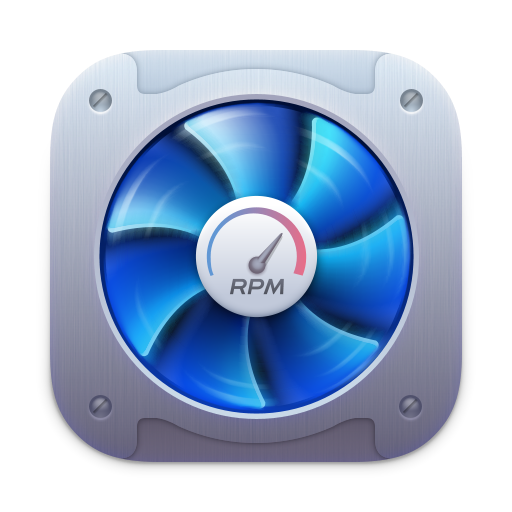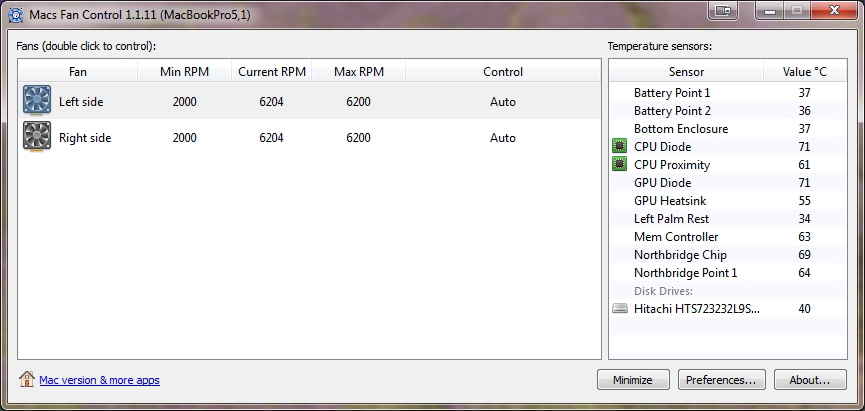

- #MACS FAN CONTROL 2000 RPM INSTALL#
- #MACS FAN CONTROL 2000 RPM PRO#
- #MACS FAN CONTROL 2000 RPM CODE#
- #MACS FAN CONTROL 2000 RPM MAC#
Fans remove heat that's generated by the different components.
#MACS FAN CONTROL 2000 RPM INSTALL#
This being your final step, install it and check performance. Install the HDD in the optical bay caddy. You will want to run AHT here again to verify all is well. If you encounter issues here, it's related to the SSD installation. Since this is your objective, this is the next logical step.
#MACS FAN CONTROL 2000 RPM CODE#
Issue - you will have a diagnostic code to start working with to solve the problem No issue - you have a good baseline to start working with If there is an problem, this tool will likely tell you what the issue is (if there is one). Hold the D key while booting from a powered off state with the AC adapter connected. Regardless if the problem goes away in the previous step, run Apple Hardware Test (AHT). If the problem goes away, then you know it's due to an issue that was introduced due to the modification.
#MACS FAN CONTROL 2000 RPM PRO#
Return your MacBook Pro to it's original configuration. Any/all of these could be malfunctioning (or detecting) a malfunction to cause the SMC to spin up your fan. There are sensors for ambient air, the heat sink/pipe, the palm rest, the CPU, the GPU, the hard drive, etc. You most likely have a malfunctioning sensor, and it's not necessarily restricted to the CPU. One thing that I like in Macs is that you never hear the fans while you work.

Checking the temperatures (always very low).That's strange because my other MacBook Pro (Mid 2010) is always quiet while I work, you start hearing the fans only under load. When I leave the MBP alone for 10 minutes, it becomes quiet again (you can't hear anything) but as soon as I start the simplest application, there go the fans at 2000 RPM. The problem is, as soon as I make the smallest action (like opening Finder), the fans start going at 2000 RPM (which seems to be the minimum speed on this machine) and you can always hear them in background. I was getting much better performances (booting Sierra in 18 seconds, instead of 30 seconds when it was in the Superdrive location). So I swapped the location of the HDD and SSD putting the HDD in the caddy. “Auto” keeps the default behavior, but opening up “Custom” allows you to set a specific RPM value, or set a target temperature.I installed a HDD+SSD setup on this MacBook Pro 15" Late 2011.Īt first I installed the SSD where the Superdrive was with an optical bay HDD caddy, but then I saw in System Informations -> SATA that while the speed link was 6 Gigabit, the negotiated speed was 3 Gigabit. When it starts, you’ll see a list of all your fans and the option to set custom controls. Get started by downloading the Macs Fan Control app and moving it to the Applications folder. It’s also possible that running fans at max speed for extended periods could lead to damage, so try not to torture your laptop. With either option, you should monitor the temperatures of your CPU and other components and make sure you’re not causing damage to your system. Keep in mind that this will make your system run a lot hotter, and could lead to system instability if you let it go too far.

On the other hand, if you hate fan noise, you can manually turn them down. This makes a lot of noise, which is why the auto-control tries to slow it down. Usually, this kicks in before the temperature gets too high, but you can manually push your CPU farther by turning the fan speed up farther than Apple usually allows.
#MACS FAN CONTROL 2000 RPM MAC#
Your Mac throttles your CPU when it gets too hot, slowing it down significantly until the temperature gets under control.


 0 kommentar(er)
0 kommentar(er)
